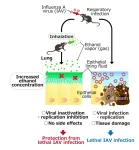(Press-News.org)
· Bladder cancer is the fourth-most diagnosed cancer in men, and survival for patients with advanced bladder is less than a year
· Doctors don’t know which bladder cancer patients will benefit from immunotherapy
·Treatment of patients with ineffective therapy causes unneeded harm and delays treatment with optimal therapies
Chicago --- In a discovery that could improve the survival of bladder cancer patients, Northwestern Medicine scientists have developed a biomarker signature test to predict which tumors will respond to immunotherapy.
Checkpoint immunotherapy drugs, which activate the body's immune system to recognize a tumor, are effective for only about 20% of bladder cancers. But clinicians don’t know which patients will benefit and why they are not more effective for all patients.
In the new study—with multiple international collaborators—Northwestern University Feinberg School of Medicine investigators identified three types of tumors that could respond to immunotherapy and two that could not. Using a combination of gene expression profiling, mutations and spatial proteomics, the scientists also analyzed the non-responsive cancers to identify potential new drugs and therapies that could be used to make them responsive to immunotherapy.
The study will be published April 27 in Nature Communications.
Bladder cancer, the fourth-most diagnosed cancer in men in the U.S., is often lethal, and has not seen improvement in survival for the last 30 years.
“Immunotherapy has changed the way we treat bladder cancer, but it has significant limitations in that most patients will not respond to therapy,” said lead investigator Dr. Joshua Meeks, associate professor of urology at Feinberg and a Northwestern Medicine urologist. “Thousands of patients have their bladder removed every year, and treating these patients with immunotherapy could improve survival and potentially increase their chance of keeping their bladder rather than having it surgically removed.”
In this study, investigators started with a Phase II trial of 82 patients treated with Keytruda (an immunotherapy) before bladder removal. This was a unique trial that evaluated the gene expression profile before and after Keytruda, with the ability to fully measure the response to Keytruda when the bladder was removed. Normally, Keytruda and other immunotherapies are used in patients with metastatic cancer, and the biological changes that occur in the tumor are unable to be monitored with tumor biopsies. By profiling the transcriptome, DNA alterations, and spatial changes that occurred in tumors treated with Keytruda, investigators were able to identify what features were associated with response or resistance.
For example, one-third of tumors were found in a subtype with very few tumor-infiltrating immune cells but increased expression of the oncogene pathway regulated by FGFR3 and a novel regulatory network of genes activated by an epigenetic regulator KDM5B. By targeting FGFR3 or KDM5B, the investigators could re-awaken an immune response. Clinical trials using new combinations of medications and immunotherapy to overcome immune resistance will start at Northwestern Medicine within the following year.
In addition, the study’s findings also provide “a more functional cancer genome atlas,” said Meeks, who also is the Edward Schaeffer, M.D., Ph.D. Professor of Urology and a member of the Robert H. Lurie Comprehensive Cancer Center of Northwestern University. “The current genome atlas looks at the fundamental building blocks of bladder cancer but doesn’t describe any treatment. That’s what makes this evaluation significant. This is about how bladder cancer responds to immunotherapy.”
The Cancer Genome Atlas is a National Cancer Institute cancer genomics program that molecularly characterized over 20,000 primary cancers. The lead author of this paper, Dr. A. Gordon Robertson, was also a lead investigator in the bladder cancer genome atlas.
The findings resulted from multiple collaborations with international groups that could perform trials with immunotherapy that were not available in the U.S. “Through team science endeavors, we were able to leverage different expertise and rare clinical trial specimens to answer important questions about which patients will respond to immunotherapy for the treatment of bladder cancer,” Meeks said.
Northwestern scientists collaborated with lead clinical investigators from Italy (Dr. Andrea Necchi) and the U.K. (Dr. Thomas Powles.) to develop a biomarker with bioinformaticists from Canada and France (Clarice Groeneveld). Investigators then validated this biomarker in a third cohort treating patients worldwide.
Major funding for the research was from the Polsky Urologic Cancer Institute of the Robert H. Lurie Comprehensive Cancer Center of Northwestern University at Northwestern Memorial Hospital, the AACR-Bayer Innovation and Discovery Grant, the U.S. Department of Defense and the Veterans Health Administration.
END
Down Memory Lane: Peter Ellinger’s Memoirs details the life of Law Professor Peter Ellinger, which has taken him around the world from Israel, to the United Kingdom, Australasia and finally Singapore, where he has chosen to retire. From his escape from Austria during Hitler’s reign, to his growing-up years in Israel, academia and legal practice, and his eventual retirement, this book takes you on a journey in time alongside Professor Ellinger.
Professor Ellinger is a Professor Emeritus of the National University of Singapore ...
A new paper in FEMS Yeast Research, published by Oxford University Press, reveals the possible origin story of lager beers. Using historical records and contemporary phylogenomics research, investigators here show where lagers likely first originated: at the court brewery (Hofbräuhaus) of Maximilian the Great, elector of Bavaria, in Munich in 1602.
Beer has been made since ancient times. Recent archaeology shows evidence of brewing in the eastern Mediterranean some 13,000 years ago. Although from the origins of brewing until the early 20th century, ale was ...
Researchers at Tokyo Tech have discovered hidden chemical order of the Mo and Nb atoms in disordered Ba7Nb4MoO20, by combining state-of-the-art techniques, including resonant X-ray diffraction and solid-state nuclear magnetic resonance. This study provides valuable insights into how a material’s properties, such as ionic conduction, can be heavily influenced by its hidden chemical order. These results would stimulate significant advances in materials science and engineering.
Determining the precise structure of a crystalline solid is a challenging endeavor. Materials properties ...
The U.S. Department of Energy’s (DOE) Argonne National Laboratory has named Claus Daniel as Associate Laboratory Director for Advanced Energy Technologies (AET). He will begin his new role on Monday, May 1.
Daniel will join Argonne from Carrier Corporation, where he leads engineering partnerships and sustainability as part of Carrier’s strategy and innovation team. He manages the effort to decarbonize the product portfolio, with activities spanning 16 time zones in the U.S., Europe and Asia. Prior to joining Carrier, Daniel spent 16 years with DOE’s Oak Ridge National Laboratory (ORNL) in a number of roles.
“It is an exciting ...
The vast majority of AI models used in medicine today are “narrow specialists,” trained to perform one or two tasks, such as scanning mammograms for signs of breast cancer or detecting lung disease on chest X-rays.
But the everyday practice of medicine involves an endless array of clinical scenarios, symptom presentations, possible diagnoses, and treatment conundrums. So, if AI is to deliver on its promise to reshape clinical care, it must reflect that complexity of medicine and do so with high fidelity, says Pranav ...
New research has revealed children’s physical activity in the UK has largely returned to pre-pandemic levels – but children are still more sedentary during the week.
The study, led by the University of Bristol, found that by summer last year 41% of children were meeting the national recommended physical activity guidelines of an hour on average of moderate to vigorous physical activity daily. Although this shows an improvement from the immediate aftermath of the COVID-19 pandemic, when little more than a third (37%) were meeting this target, it means the majority of children were still ...
Inhaling low concentrations of ethanol vapor can disable the influenza A virus in mice, without harmful side effects, says a new study by scientists at the Okinawa Institute of Science and Technology (OIST). The scientists believe it may also treat similar viruses such as the one that causes Covid-19.
Prof. Tsumoru Shintake, who leads the Quantum Wave Microscopy Unit at OIST, first proposed the idea to use ethanol vapor to treat respiratory tract infections. He set out to test the approach with his colleague, Prof. Hiroki Ishikawa, leader of the Immune Signal Unit at OIST, and their team members.
“Ethanol is an effective disinfectant ...
Nickel-zinc (Ni-Zn) batteries are promising due to their high output voltage, high theoretical specific energy, high safety, and low cost. However, rechargeable alkaline Ni-Zn batteries are challenging, since the cathodic side reaction of oxygen evolution results in low energy efficiency and poor stability.
Recently, a research group led by Prof. YANG Weishen and Dr. ZHU Kaiyue from the Dalian Institute of Chemical Physics (DICP) of the Chinese Academy of Sciences proposed ...
Methanol is a potential feedstock for biomanufacturing since it's easily obtained in an environment-friendly manner. But it is still challenging to construct a microbial cell factory for methanol-based bioproduction due to the toxicity of methanol and complex cellular metabolism.
Recently, a research group led by Prof. ZHOU Yongjin from the Dalian Institute of Chemical Physics (DICP) of the Chinese Academy of Sciences (CAS) has engineered yeast Ogataea polymorpha for efficient ...
SINGAPORE, 26 April 2023 – Symptoms of anxiety and depression in the post-peak pandemic era could be costing Singapore 2.9 per cent of its gross domestic product (GDP)—or nearly S$16 billion—suggests a study conducted by Duke-NUS Medical School and the Institute of Mental Health (IMH).
Publishing in the journal BMC Psychiatry, the researchers estimated the total economic burden of lost productivity due to anxiety and depression in Singapore to be S$15.7 billion (US$11.72 billion) annually, based on survey data from 5,725 Singaporean adults collected via an online panel between April and June 2022.
Using ...



